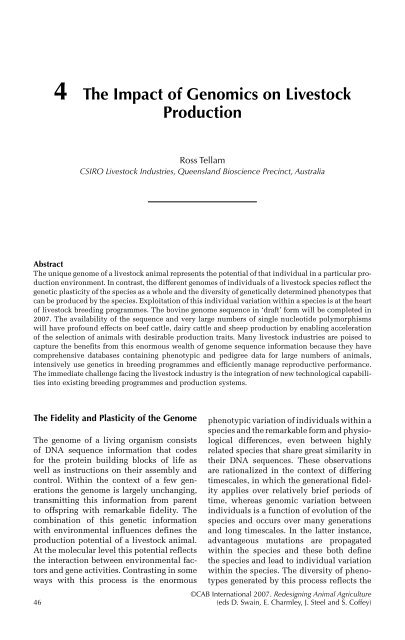Redesigning Animal Agriculture
Redesigning Animal Agriculture
Redesigning Animal Agriculture
You also want an ePaper? Increase the reach of your titles
YUMPU automatically turns print PDFs into web optimized ePapers that Google loves.
4 The Impact of Genomics on Livestock<br />
Production<br />
Ross Tellam<br />
CSIRO Livestock Industries, Queensland Bioscience Precinct, Australia<br />
Abstract<br />
The unique genome of a livestock animal represents the potential of that individual in a particular production<br />
environment. In contrast, the different genomes of individuals of a livestock species reflect the<br />
genetic plasticity of the species as a whole and the diversity of genetically determined phenotypes that<br />
can be produced by the species. Exploitation of this individual variation within a species is at the heart<br />
of livestock breeding programmes. The bovine genome sequence in ‘draft’ form will be completed in<br />
2007. The availability of the sequence and very large numbers of single nucleotide polymorphisms<br />
will have profound effects on beef cattle, dairy cattle and sheep production by enabling acceleration<br />
of the selection of animals with desirable production traits. Many livestock industries are poised to<br />
capture the benefits from this enormous wealth of genome sequence information because they have<br />
comprehensive databases containing phenotypic and pedigree data for large numbers of animals,<br />
intensively use genetics in breeding programmes and efficiently manage reproductive perform ance.<br />
The immediate challenge facing the livestock industry is the integration of new technological capabilities<br />
into existing breeding programmes and production systems.<br />
The Fidelity and Plasticity of the Genome<br />
The genome of a living organism consists<br />
of DNA sequence information that codes<br />
for the protein building blocks of life as<br />
well as instructions on their assembly and<br />
control. Within the context of a few generations<br />
the genome is largely unchanging,<br />
transmitting this information from parent<br />
to offspring with remarkable fidelity. The<br />
combination of this genetic information<br />
with environmental influences defines the<br />
production potential of a livestock animal.<br />
At the molecular level this potential reflects<br />
the interaction between environmental factors<br />
and gene activities. Contrasting in some<br />
ways with this process is the enormous<br />
phenotypic variation of individuals within a<br />
species and the remarkable form and physiological<br />
differences, even between highly<br />
related species that share great similarity in<br />
their DNA sequences. These observations<br />
are rationalized in the context of differing<br />
timescales, in which the generational fidelity<br />
applies over relatively brief periods of<br />
time, whereas genomic variation between<br />
individuals is a function of evolution of the<br />
species and occurs over many generations<br />
and long timescales. In the latter instance,<br />
advantageous mutations are propagated<br />
within the species and these both define<br />
the species and lead to individual variation<br />
within the species. The diversity of phenotypes<br />
generated by this process reflects the<br />
©CAB International 2007. <strong>Redesigning</strong> <strong>Animal</strong> <strong>Agriculture</strong><br />
46 (eds D. Swain, E. Charmley, J. Steel and S. Coffey)










